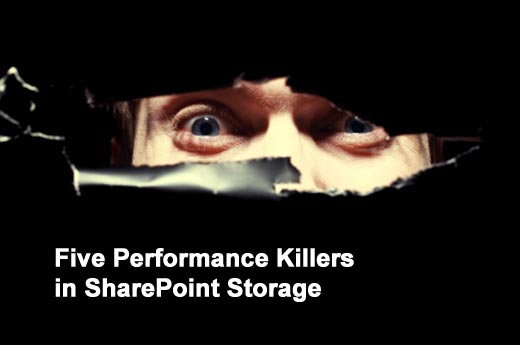Rapid user adoption is positive for any organization leveraging SharePoint for content collaboration and version control. As user adoption increases, however, so does the amount of data that must be stored in SharePoint. Content overload can wreak havoc on SharePoint infrastructure, and can become a leading cause of poor performance — not to mention the corresponding management headaches. For example, as the amount of content steadily increases, so does the need to scale database capacity and SQL Server processing power to ensure that performance matches user demand. When this happens, organizations face a dilemma: cope with poor SharePoint performance, or bite the bullet and buy additional SQL storage space and computing power to catch up with demand. Luckily, there is a third alternative.
Quest Software, a leading provider of SharePoint tools for the enterprise, has identified five common storage performance killers in SharePoint that organizations fall victim to, and suggests an easy, cost-effective alternative for resolving SharePoint content overload — data externalization.
Click through for five SharePoint performance killers and an alternative for resolving the content overload, as identified by Quest Software.
Most SharePoint content is saved in SQL Server as unstructured data, otherwise known as BLOBs (Binary Large Objects). It takes extra processing power and time to read data from these files, and yet, they contribute to nearly 95 percent of storage overhead in SharePoint content databases. Simply put, unstructured data is taking over SQL server space.
SharePoint is not optimized to house large media files such as videos, images and PowerPoint presentations. As more of this content is stored in SharePoint, it amplifies the likelihood that users will experience browser timeout, slow Web server performance and upload and recall failures.
It’s not uncommon for the majority of SharePoint content to go completely unused for long periods of time. Many organizations waste space by applying the same storage treatment for old, unused data as they do for new, active content.
As SharePoint content grows, its supporting hardware can become under powered if growth rates were not accurately forecasted from the start. Organizations unable to invest in new hardware need to find alternatives that enable them to adhere to best practices and keep SharePoint performance optimal.
Many organizations have not yet explored Microsoft’s recommended externalization capabilities, Remote BLOB Storage (RBS) and External BLOB Storage (EBS), and, therefore, are missing out on significant storage and related performance benefits.
By taking advantage of Microsoft’s data externalization features, SharePoint administrators are able to move large, old and unused data from a SQL server content database to secondary, less expensive repositories, all while keeping the data accessible to end users via SharePoint.








